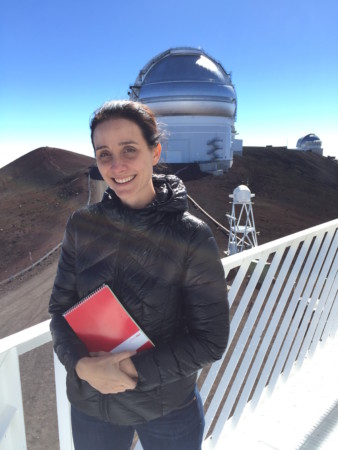
Several days ago, I reviewed Illima Loomis’ latest picture book, ‘Ohana Means Family. Anyone interested in sharing Hawaiian culture with children should consider this book. Today, readers can learn more about Loomis and why she chose to focus on a Hawaiian traditional food.
Ilima, you have a diverse writing portfolio. When you are not writing children’s books what is your favorite genre?
Writing children’s books is a joy. But as a journalist, I have loved covering science. I am also the author of Eclipse Chaser: Science in the Moon’s Shadow.
When and why did you start writing children’s books?
It is kind of a funny story. I never had aspirations to become a children’s writer as I saw myself as a journalist first and foremost. My first book, Rough Riders, was a nonfiction book about the history of paniolo, Hawaiian cowboys. Never wanting to miss an opportunity to repurpose my research, I decided to pitch my publisher on a picture book on the same topic. Ka’imi’s First Round-Up was published two years later. To my surprise, I loved the experience and started looking for opportunities to write more.
Can you identify three children’s authors who have influenced your writing style and explain how their books have affected you?
There are a lot of children’s authors I admire but I can point to one book in particular that influenced me. When I was first getting more serious about children’s writing, I perused a lot of picture books to get a feel for what was out there. Mo Willems’ City Dog, Country Frog was the first book that really opened my eyes to picture books as a literary art form. The writing was so simple and told such a powerful, emotional story in so few words, which is one of the hardest things to do as a writer. It was a mind-expanding moment for me where all of a sudden I could see that picture book writing could be so much more than I had thought. I was immediately drawn to the challenge and inspired.
What tools did you utilize to make the transition from content marketing writer and journalist to this genre? (writing groups, conferences, classes, etc. & please elaborate)
Like I already said, I read a lot of picture books to see what is current and inspiring. There is so much innovation and creativity in this space today. I read some blogs and I think some books which were helpful (this was about a decade ago, so, unfortunately, I can’t remember which one).
I attended an SCBWI workshop and conference here in Hawaii. Most importantly, I made time to write, and over a period of several years, I wrote several picture book manuscripts that never went anywhere but were an important part of my learning process. I had an agent for a year or so. But it was not a successful partnership and we eventually parted ways. Finally, in 2015 I attended the ABLA Writing Workshop where I met the wonderful Kelly Sonnack, an agent at ABLA. We hit it off and ended up working together.
What are the three greatest challenges you have faced as a children’s author?
There are a lot of challenges in publishing that ar
e just out of your control as an author, so I don’t really count those. Ultimately you really can’t control what other people are going to like or if a publisher is going to buy your book, etc. So for me the biggest challenge has been maintaining space in my life for my own creative work.
Like a lot of people, I went through personal challenges, work pressures, and demands on my time that made it hard to focus and just drained my creative energy. I stopped writing for a while and learned that I can’t be passive and just wait for inspiration. I need to fight for my creative self. For anyone struggling with this, I recommend The Artist’s Way, which really helped me.
Three out of four of your children’s books have Hawaiian themes. What do you hope to accomplish by writing stories about Hawaiian culture and history? And/or How does your Hawaiian culture influence your children’s book writing?
I’m not Native Hawaiian but was born and raised here. My family has been here for three generations, so Hawaii is an important part of who I am. The culture and people of Hawaii have definitely inspired my work, and I’m proud to share that with readers via my books.

What prompted your interest in solar physicist Shadia Habbal and her work with solar eclipses? What did you hope readers will learn from her story?
Actually, my agent Kelly helped inspire my book Eclipse Chaser, as she had sold other books to the Scientists in the Field series and suggested that I look around for a scientist with an adventurous job who would make a good subject. As a science writer, I focused on things like astronomy and Earth sciences, so I started asking some of the scientists I knew for suggestions.
When I heard about Shadia and how she traveled around the world chasing solar eclipses I thought she was perfect. You know you’ve found a good subject when you think to yourself, “I can’t believe nobody’s written a book about this person before!”
Why did you write a book about a traditional Hawaiian food? Why did you choose poi?
Poi is the most traditional staple Hawaiian food, and I wanted to write about it for a long time. I grew up eating poi. Like a lot of children in Hawaii, it was one of the first foods that were given to me as a baby. It is hugely important to the people and culture of Hawaii, but I had never seen a book about it.
I tossed around a lot of ideas but never found one that felt right. Finally one day I was reading “The House That Jack Built” and knew it was the perfect basis for the story. The building rhyme was a natural vehicle to show how poi — and all food — connect to the earth, rain, sun, and people.
What resources did you use to research this topic and did your family’s heritage affect your writing?
Growing up here I was familiar with the process of kalo farming and had also reported on Hawaiian water rights as a journalist. This helped inspire the idea of using poi to write about the connection between food, land, water, and people.
Before the book was published, I asked Hōkūao Pellegrino, a Hawaiian cultural expert, to review it and he shared some valuable feedback, including correcting my use of Hawaiian diacritical marks. I’m not a Hawaiian language speaker so I really appreciated his help in correcting the text.
Why did you choose to use a cumulative style when writing Ohana Means Family?
As I said, the form of the poem really helped inspire the book’s concept, and the cumulative rhyme was perfect for showing the connection between food and the land.
After completing Ohana Means Family, what do you hope your readers will remember about the story?
Readers on the mainland may not have heard of poi before, so I hope the book introduces them to this important food and gives them an idea of its importance in Hawaii’s culture.
Can you describe how Kenard Pak’s illustrations add to your story?
I was over the moon when I saw Kenard Pak’s illustrations because they are so beautiful and a perfect complement to the words. I know Kenard did a lot of research to accurately depict kalo farming in Hawaii and I appreciate the time he took to make sure he got it right.
One thing I love most about his illustrations is the way they mirror the pattern of the rhyme, starting with a close-up look at something small, like the kalo corm, and gradually zooming out and getting bigger and bigger until you see the whole island, ocean, and sun. It not only matches the text but also connects to the bigger theme of the book by showing how we’re all connected with each other and our world.
Can you offer three suggestions for writers who are considering writing their first children’s book?
Read as much as you can in your genre, and especially read what’s current and new. Picture books have changed a lot since the days of Dr. Seuss and Margaret Wise Brown. You’ll be inspired by today’s authors.
For most of us, it’s hard to “find the time” to write. Don’t beat yourself up or be hard on yourself. Set aside what time you’re realistically able to commit to, even if it’s just a few minutes every day, or one hour on the weekend. Don’t minimize your creative pursuit, honor that part of yourself, and give yourself permission to make mistakes and explore.
Enjoy.
Are you currently working on any children’s books? If so, can you share any information or anticipated publication dates?
I have some projects in the works! Stay tuned.
Is there anything else that you would like my readers to know?
If you ever get a chance to taste poi, try it! It’s an unusual taste and consistency to Western palettes. Give it a try with an open mind and think about the warm sun, cool rain, and wise hands that made it.
DISCLOSURE
Sandra Bornstein received a complimentary copy of ‘Ohana Means Family.
BIO
Sandra Bornstein is the author of May This Be the Best Year of Your Life. Sandra’s memoir highlights her living and teaching adventure in Bangalore, India. She was a licensed Colorado teacher who taught K-12 students in the United States and abroad. Sandra also taught college-level courses at Front Range Community College and the University of Colorado-Boulder. In addition to reviewing books and interviewing authors, Sandra is a freelance lifestyle and travel writer. Many of Sandra’s stories appear on the For Readers page. Additional stories can be read on TheTravelingBornsteins website.
Connect with Sandra